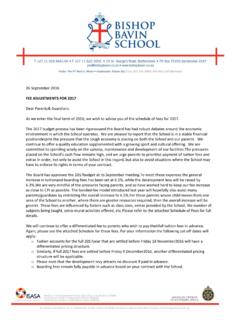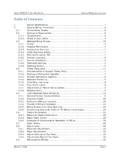Transcription of Energy Efficiency Trends in the Electric Power …
1 december 2017 ReportEnergy Efficiency Trends in the Electric Power IndustryPrepared by: Adam CooperIEI Report: december 20171 EXECUTIVE SUMMARYE nergy Efficiency (EE) programs are a win-win customers save Energy and Electric companies reduce carbon emissions. For several decades, Electric companies have supported their custom-ers interest in Energy Efficiency by providing incentives and information that lower the cost of purchasing Energy -efficient appliances and devices and encourage Energy management through Energy Efficiency and demand response to the most recent information, Electric company customer-funded EE programs ( , both Efficiency and demand response programs) saved 183 terawatt-hours (TWh) of electricity in 2016, up from 169 TWh in 2015. EE savings grew 45 percent over the past 5 years, from 126 TWh saved in 2012 to 183 TWh in 2016. In 2016, EE programs avoided the generation of 136 million metric tons of carbon In 2016, EE programs saved enough electricity to Power 20 million homes for one 1.
2 Energy Efficiency Savings and Carbon Dioxide (CO2) Emissions Avoided (2008-2016)1. Environmental Protection Agency Greenhouse Gas Equivalencies Calculator: Ibid3. Trends in the Program Administrator Cost of Saving Electricity for Utility Customer-Funded Energy Efficiency Programs. Lawrence Berkeley National Laboratory. January 2008, customer-funded EE program expenditures more than doubled, increasing from $ billion to $ billion in 2016. A 2017 report from Lawrence Berkeley National Laboratory found EE programs continue to be very cost-effective, delivering Energy savings at a cost of roughly 2 cents per kWh over the lifetime of the Billion kWh SavedMillion metric tons of CO2 avoidedMillion homes powered for 1 Efficiency Trends in the Electric Power Industry2 Similar to renewable Energy resources, EE programs reduce carbon dioxide emissions and are an important part of the Energy mix.
3 Figure 2 shows that: EE programs in 2016 saved three-times the amount of electricity generated by solar resources in 2. EE Programs Saved More Energy than Solar Generated in 2016It is widely recognized that supportive regulatory frameworks are key to expanding the Electric Power industry s already large commitment to EE. Homes and businesses that take advantage of EE programs benefit from them. States with regulatory frameworks that support Electric company investments in EE programs tend to be leaders in In total, 33 states have approved fixed-cost recovery mechanisms 17 states have revenue decoupling and 16 have lost revenue adjustment mechanisms (see Table 1).P In total, 30 states have performance incentives in details on the regulatory frameworks by state are provided in the second half of this 1. Summary of State Regulatory Frameworks in 2017 Energy Efficiency Incentive MechanismsNumber of StatesPendingFixed-Cost Recovery MechanismsLost Revenue Recovery160 Revenue Decoupling171 Performance Incentives300 Energy Efficiency Resource Standard (EERS)26056 183 226266 0 50 100 150 200 250 300 Terawatt-hours (TWh)Hydro WindSolar IEI Report: december 20173 INTRODUCTIONH istorically a product of public policy with varying levels of participation, EE programs are now viewed by the Electric Power sector as an essential element in an ever-expanding set of service offerings high Efficiency lighting, smart thermostats, dynamic rates, renewable Power options, storage, and more to meet the expectations of Electric customers who live in an on-demand, service-centric world.
4 For customers, this is the beginning of a new era of choice and control over their Energy supply and use. Increasingly, customers are gaining access to technology that gives them the ability to tailor Energy use to their personal needs and wants. The goal of EE programs is to produce Energy and capacity savings that benefit customers, Electric companies, and society as a whole. For several decades, Electric companies have supported their customers interest in Energy Efficiency by providing incentives and information that lower the cost of purchasing Energy -efficient appliances and devices and encourage Energy management through Energy Efficiency and demand response programs. The focus of Energy Efficiency programs is to reduce Energy consumption while increasing Energy input productivity ( , fewer kilowatt-hours in exchange for equal or improved output). The focus of demand response (DR) programs is to reduce peak Energy demand when the wholesale price of electricity is relatively high or for Power system reliability Energy Efficiency SAVINGSIn 2016, EE programs saved 183 TWh of electricity, enough to Power 20 million homes for one year, and avoided the generation of 136 million metric tons of carbon dioxide (see Figure 3).
5 4 The Energy savings from EE programs is equivalent to percent of total end use electricity consumption in Environmental Protection Agency Greenhouse Gas Equivalencies Calculator: Figure 3. Energy Efficiency Savings and Carbon Dioxide (CO2) Emissions Avoided (2008-2016) Billion kWh SavedMillion metric tons of CO2 avoidedMillion homes powered for 1 Efficiency Trends in the Electric Power Industry4Of the total 183 TWh saved in 2016, 29 TWh are incremental Energy savings from either new programs or new participants in existing programs in 2016. Estimates of Energy savings are developed based on the following: Energy savings due to past program participation, which continue to deliver measurable and verifiable savings ( , a high Efficiency refrigerator installed in 2011 continues to save Energy in 2016). Energy savings due to customer participation in new programs ( , in 2016, an Electric com-pany offers a brand new LED product rebate and a customer purchases and installs an LED lamp in 2016).
6 Energy savings due to new participants in an existing program ( , in 2016, an Electric com-pany continues to offer rebates for high Efficiency refrigerators and a customer utilizes the rebate to purchase an eligible refrigerator).EE programs are cost-effective ways to manage Energy use. A 2017 report from Lawrence Berke-ley National Lab found that Electric company customer-funded Efficiency programs that reported results during 2009-2013 delivered Energy savings at a cost of roughly 2 cents per kilowatt-hour (kWh) saved over the lifetime of the Similar to renewable Energy resources, EE programs reduce carbon dioxide emissions and are an important part of the Energy mix. Figure 4 shows that: EE programs in 2016 saved three-times the amount of electricity generated by solar resources in 2016. EE programs saved about 80 percent of the electricity generated by wind resources in Trends in the Program Administrator Cost of Saving Electricity for Utility Customer-Funded Energy Efficiency Programs.
7 Lawrence Berkeley National Laboratory. January 4. EE Programs Saved More Energy than Solar Generated in 201656 183 226266 0 50 100 150 200 250 300 Terawatt-hours (TWh)Hydro WindSolar IEI Report: december 201752016 Energy Efficiency EXPENDITUREST able 2 shows EE program expenditures of $ billion in the United States in 2016, an increase of 4 percent from 2015. IEI believes that the slight increase is a result of more state regulatory poli-cies supporting customer-funded Energy Efficiency programs, as well as state Energy Efficiency resource standards which set Energy savings goals and targets that tend to increase over time. With Energy Efficiency resource standards in half of all states and with more than 30 states with regulatory frameworks that support Electric company investments in EE, IEI believes that expenditures are likely to exceed $9 billion by companies, encompassing investor-owned, municipal, cooperative, and federal utilities, are the largest providers of EE programs in the United States, with program-related expenditures of $ billion, comprising 88 percent of expenditures CompanyThird-Party AdministratorElectric Company Share of TotalPercent Increase2008$3,395,273,000 $3,009,522,000 $385,751,000 89% 2009$3,770,398,000 $3,312,287,000 $458,111,000 88%11%2010$4,831,868,000 $4,271,691,000 $560,177,000 88%28%2011$5,711,277,000 $4,914,351,000 $796,926,000 86%18%2012$5,861,219,000 $5,244,288,000 $616,931,000 89%3%2013$6,440,303,000 $5,811,865,000 $628,438,000 90%10%2014$ 7, 2 8 5 , 6 3 7.
8 0 0 0 $6,589,178,000 $696,459,000 90%13%2015$ 7, 2 3 2 ,9 3 7, 0 0 0 $6,490,523,000 $742,414,000 90%-1%2016$7,513,376,000$6,613,805,000$8 99,571,00088%4%Table 2. Customer-Funded Energy Efficiency Expenditures (2008-2016)Figure 5. 2016 Energy Efficiency Expenditures Top 10 StatesFigure 5 shows the 10 states with the largest 2016 Energy Efficiency expenditures. These 10 states accounted for 58 percent of Electric Efficiency expenditures in 2016. California leads the states with $ billion in expenditures, with Massachusetts second and New York 300 600 900 1,200 1,500 CA MA NY NJ FL MN IL MD WA PA $ MillionState1,26152050239335734127126323 5218 Energy Efficiency Trends in the Electric Power Industry6 Though expenditures at the national level grew modestly in 2016, two states increased their Energy Efficiency program expenditures by 50 percent or more relative to 2015 Louisiana and New provide some sense of the relative magnitude of spending, it is important to consider spend-ing on Energy Efficiency in both absolute terms and in relation to the state s share of the nation s total population and electricity consumption.
9 Table 3 shows 2016 Energy Efficiency expenditures, population by state, and the state s relative share of Energy Efficiency expenditures, popula-tion, and electricity states California, Connecticut, Hawaii, Maryland, Massachusetts, Minnesota, New Jersey, Rhode Island, Vermont have 2016 Energy Efficiency expenditure shares that are at least double their share of electricity consumption. Energy Efficiency programs in these states have deliv-ered substantial cumulative Energy savings, thus lowering the per-capita consumption of Electric -ity. This is reflected in the fact that in these nine states, the percent of electricity consumption is lower than the percent of 3. Summary of Customer-Funded Energy Efficiency Efforts by StateState2016 Energy Efficiency Expenditures ($Millions)Population (2016 Cen-sus)% of Total 2016 EE Expenditures% of Population% of 2016 Electricity ConsumptionAK$ 741, $ 4,863, $ 2,988, $ 6,931, $1, 39,250, $ 5,540, $ 3,576, $ 681, $ 952, $ 20,612, $ 10,310, $ 1,428, $ 3,134, $ 1,683, $ 12,801, $ 6,633, $ 2,907, $ 4,436, Report.
10 december 20177 State2016 Energy Efficiency Expenditures ($Millions)Population (2016 Cen-sus)% of Total 2016 EE Expenditures% of Population% of 2016 Electricity ConsumptionLA$ 4,681, $ 6,811, $ 6,016, $ 1,331, $ 9,928, $ 5,519, $ 6,093, $ 2,988, $ 1,042, $ 10,146, $ 757, $ 1,907, $ 1,334, $ 8,944, $ 2,081, $ 2,940, $ 19,745, $ 11,614, $ 3,923, $ 4,093, $ 12,784, $ 1,056, $ 4,961, $ 865, $ 6,651, $ 27,862, $ 3,051, $ 8,411, $ 624, $ 7,288, $ 5,778, $ 1,831, $ 585, $7,513 323,127,500 Energy Efficiency Trends in the Electric Power Industry8 Energy Efficiency REGULATORY FRAMEWORKSThe regulatory environment in each state is a major factor in determining the size of customer-funded EE programs. Three regulatory mechanisms are critical for aligning incentives for Electric companies to treat demand-side resources as financial equivalents to supply-side investments: direct cost recovery, fixed-cost recovery, and performance incentives.





